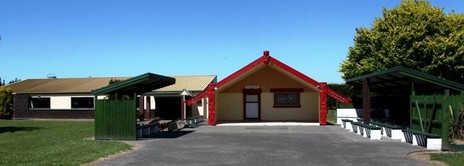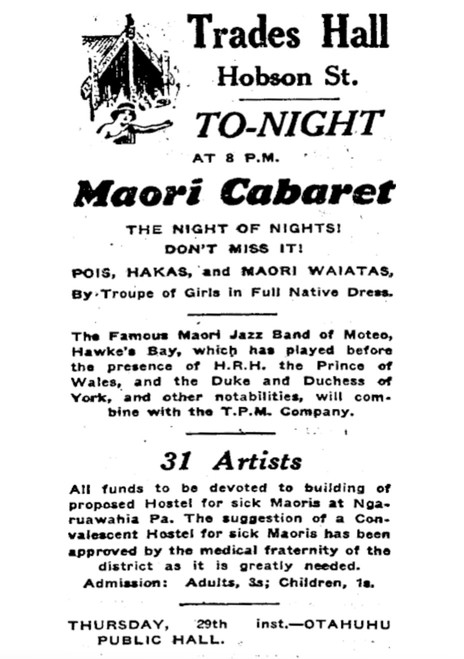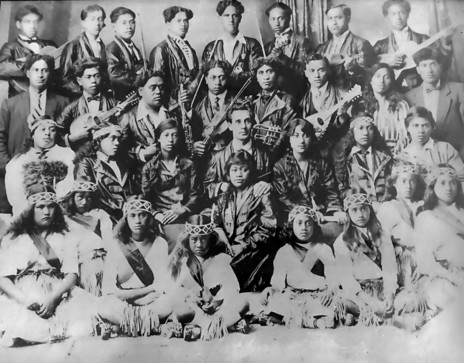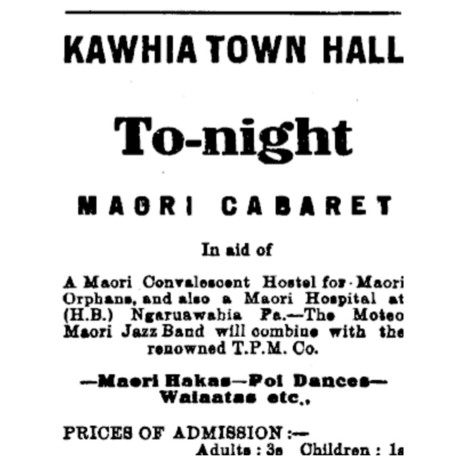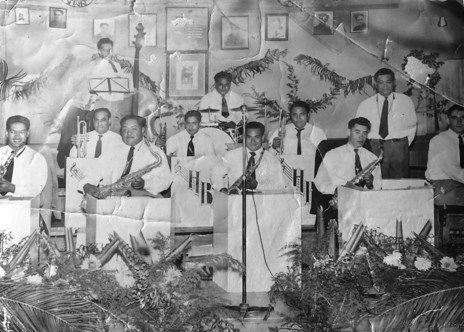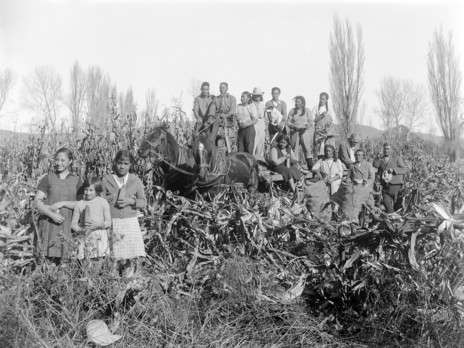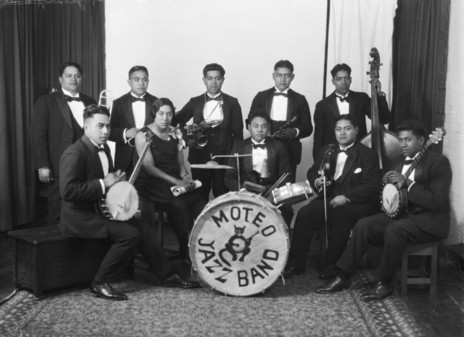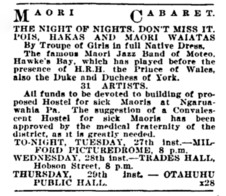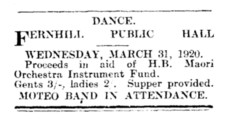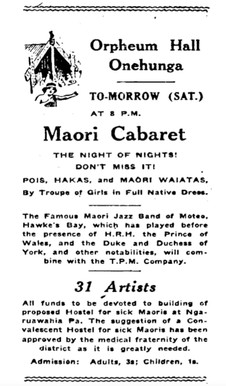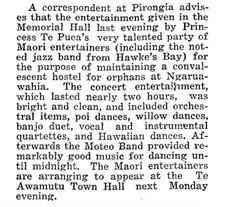Smith – the composer of ‘Beneath the Māori Moon’ – was extremely influential in New Zealand popular music, having spent nearly 20 years in Utah, studying music and performing in dance bands. He was the music teacher at the Māori Agricultural College, a Mormon institution founded in 1913 at Bridge Pā, 20 km north of Moteo. In 1918, after five years at the college, Smith and his wife left for Auckland. He became a stringed instrument teacher, with Peter Posa and Bob Paris among his pupils in the 1950s.
Most of the Mormon teachers at the Māori Agricultural College were recruited from the United States so it is possible that the next musical director brought with him the latest jazz arrangements and took over training the Moteo dance band.
“The Moteo String Orchestra ... was the most advanced Māori ensemble at the time.”
In 2017 Charles Ropitini of the Museum Theatre Gallery (MTG) Hawke’s Bay curated the exhibition He Manu Tīoriori: Songbirds – 100 Years of Ngāti Kahungunu Music. In a backgrounder for the Hawke’s Bay Today paper he wrote, “While we know the Moteo musicians were trained by a person ‘from overseas’, that person is not named. Could it be Walter Smith? Certainly, the Moteo String Orchestra (as they were known through World War I) was the most advanced Māori ensemble at the time and it would have been natural for Walter to extend their skills to the new jazz style. The Moteo Jazz Band went on to become the Harry Brown Dance Band of the 1940s and 50s, one of the most popular bands in Hawkes Bay after World War II.”
The Moteo Marae, founded in 1869, was the centre of Māori social activity for the region. It connects ancestrally to the waka Tākitimu, the mountain Kahurānaki and the awa Tūtaekurī. Many musical groups originated in the small community and the neighbouring village of Waiōhiki. Apart from their dance band the people of Moteo also helped establish the Waipatu-Moteo Pastorate Choir which performed well at the 1920s-30s national Māori choir competitions, and the Te Reo o Hamuera Rātana Brass Band, established in 1935 as Rātana’s teachings spread throughout the North Island. (The band still exists.)
From early in the 20th Century the importance of music was stressed in Māori affairs in Hawke’s Bay. In 1909, former pupils of Te Aute College such as Āpirana Ngata MP and songwriter Paraire Tomoana established the Young Māori Party (YMP) to improve Māori health and welfare, and to encourage the revival of Māori arts, music and crafts. During the First World War the YMP founders encouraged their young men to fight overseas as a way of assimilating themselves into mainstream New Zealand. Ngata and Tomoana founded the Hawke’s Bay Māori Entertainers (Te Ope Ngahau O Heretaunga) to raise money for the Māori soldiers.
The lyrics of ‘E Pari Rā’, one of the best-known Māori songs, were written by Tomoana and published in 1918. The melody is reported to have been adapted by him from the ‘Blue Eyes Waltz’ which he first heard played by the Moteo Māori Orchestra.
In 1920 the Moteo Māori Orchestra played before Edward, Prince of Wales (later, briefly, King Edward VIII), and his cousin Lord Mountbatten during their visit to Rotorua where they were delayed by a rail strike. Māori were not impressed by his attitudes and called him the “racist Duke”.
The band hosted dances to fund Māhinārangi, a large carved house on Tūrangawaewae Marae in Ngāruawāhia, intended as a hospital should another epidemic occur. After playing before the future King George VI and Queen Elizabeth in Rotorua during their 1927 tour, the Māori Jazz Band of Moteo “toured Auckland fundraising then took part in a ceremony to greet the Governor-General Sir Charles Ferguson to the “model pā on the banks of the Waikato River.”
In March 1928 the band travelled to Auckland, performing at the Orpheum Hall in Onehunga, the Ōtāhuhu Public Hall, and the Trades Hall on Hobson Street. At The Auckland Star of 1 May 1928 reported that, after the band’s fundraising stint for the Māori of Ngāruawāhia, they travelled to the Waikato town, and took part in a ceremony greeting the Governor-General Sir Charles Ferguson to the “model pā” on the banks of the Waikato River. That evening, Te Puea – “wearing a mat over her European clothes” – escorted Ferguson and his wife to the front of the Kimi Kimi Hall, where “a jazz band of Hawke’s Bay Māori men, resplendent in evening clothes, played the National Anthem. Tonga Mahuta, a son of King Rata, spoke a few dignified words of welcome.”
IN THE 1930S, THE MOTEO JAZZ BAND MORPHED INTO HARRY BROWN’S ORCHESTRA.
After the formal greetings, the festivities began: “A weird Māori chant, in a minor key, was sung by an aged Māori … a short programme of dancing and native songs … a solo dance by Te Puea’s husband in a solo dance ‘full of fire and the lust of combat’, and 11 Māori maidens in a graceful poi dance, singing ‘E Pari Ra’ … the beautiful Niko Kaihau dancing a hula …”
In the 1930s, with the progression of early jazz to the more commercial swing, the Moteo Jazz Band morphed into Harry Brown’s Orchestra. Māori in the district fondly remembered the band playing Glenn Miller-style music in front of the wharenui and they later played dances in the wool stores at Port Ahuriri in Napier. The building was so large that they needed two bands at the same time, each at different ends of the shed. The band eventually purchased a bus for touring. Napier historian Patrick Parsons says that Harry Brown’s Orchestra played right up to the 1950s, at some time moving to Rotorua. Brown died in 1970 and is buried at the Moteo Urupā.
--
Thanks to Matthew Eru Wepa, whose book Great Mysteries of the Māori World first introduced me to the Moteo Jazz Band; his father Gerry Wepa played banjo in the band. Thanks also to Annette Purves (a trustee of the Moteo Marae whose grandfather Dave Karauria played in the Moteo Jazz Band), Charles Ropitini, and Chris Bourke.
